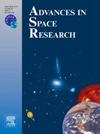A lightweight prediction model for global ionospheric total electron content based on attention-BiLSTM
IF 2.8
3区 地球科学
Q2 ASTRONOMY & ASTROPHYSICS
引用次数: 0
Abstract
The ionospheric total electron content (TEC) is a critical parameter for space weather and Global Navigation Satellite System (GNSS) applications. A Bidirectional Long Short-Term Memory neural network model with an added attention mechanism (BiLSTM-Attention) was developed in this study to predict 256 spherical harmonic coefficients (SHC). Input data for the forecasting model includes F10.7, Dst, and other feature parameters, along with a lightweight historical time series of SHC from the past day. The model output is the next day’s SHC. Then, we compare the results of SHC with those of the 1-day Center for Orbit Determination in Europe (CODE) prediction model. The correlation coefficient form model TEC with respect to the CODE TEC are 0.93 and 0.96 in 2018 and 2022, respectively, while the correlation coefficient of the 1-day CODE prediction model are 0.91 and 0.94. The results illustrate established model both in high and low solar activity years, and exhibiting enhanced robustness during geomagnetic storms. Furthermore, typical ionospheric structures such as Equatorial Ionization Anomaly (EIA) is well reproduced in the TEC prediction maps. Compared to C1PG, the proposed model offers a lighter computational load while maintaining competitive performance in global TEC prediction.
求助全文
约1分钟内获得全文
求助全文
来源期刊

Advances in Space Research
地学天文-地球科学综合
CiteScore
5.20
自引率
11.50%
发文量
800
审稿时长
5.8 months
期刊介绍:
The COSPAR publication Advances in Space Research (ASR) is an open journal covering all areas of space research including: space studies of the Earth''s surface, meteorology, climate, the Earth-Moon system, planets and small bodies of the solar system, upper atmospheres, ionospheres and magnetospheres of the Earth and planets including reference atmospheres, space plasmas in the solar system, astrophysics from space, materials sciences in space, fundamental physics in space, space debris, space weather, Earth observations of space phenomena, etc.
NB: Please note that manuscripts related to life sciences as related to space are no more accepted for submission to Advances in Space Research. Such manuscripts should now be submitted to the new COSPAR Journal Life Sciences in Space Research (LSSR).
All submissions are reviewed by two scientists in the field. COSPAR is an interdisciplinary scientific organization concerned with the progress of space research on an international scale. Operating under the rules of ICSU, COSPAR ignores political considerations and considers all questions solely from the scientific viewpoint.
 求助内容:
求助内容: 应助结果提醒方式:
应助结果提醒方式:


